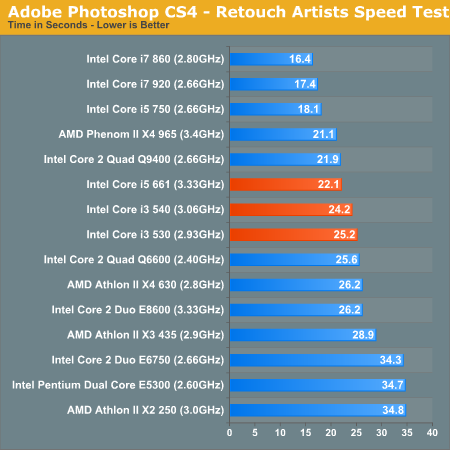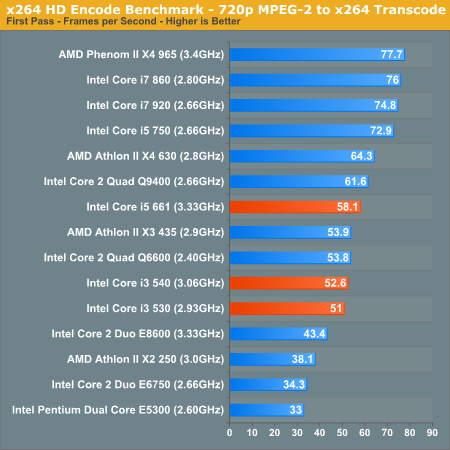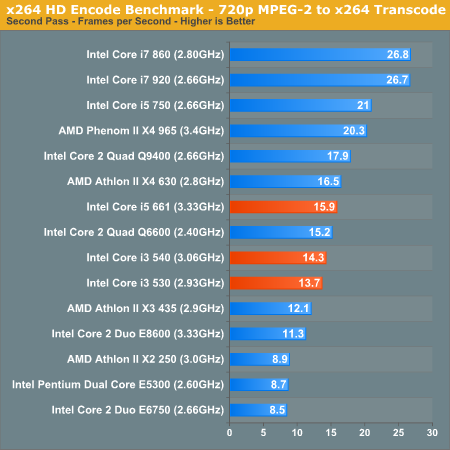The Clarkdale Review: Intel's Core i5 661, i3 540 & i3 530
by Anand Lal Shimpi on January 4, 2010 12:00 AM EST- Posted in
- CPUs
Adobe Photoshop CS4 Performance
To measure performance under Photoshop CS4 we turn to the Retouch Artists’ Speed Test. The test does basic photo editing; there are a couple of color space conversions, many layer creations, color curve adjustment, image and canvas size adjustment, unsharp mask, and finally a gaussian blur performed on the entire image.
The whole process is timed and thanks to the use of Intel's X25-M SSD as our test bed hard drive, performance is far more predictable than back when we used to test on mechanical disks.
Time is reported in seconds and the lower numbers mean better performance. The test is multithreaded and can hit all four cores in a quad-core machine.

And this is where everything changes. While our Photoshop test won't keep four cores busy 100% of the time, it's enough to give the quad-core CPUs an advantage. Here the Core i5 661 is around the speed of a Q9400 but nowhere near the similarly priced Lynnfield Core i5 750.
The Core i3 540/530 are valuable as they are both able to outperform AMD's similarly priced Athlon II X4 630. The 661 doesn't make sense here but for the price, the i3 530/540 look promising.
DivX 8.5.3 with Xmpeg 5.0.3
Our DivX test is the same DivX / XMpeg 5.03 test we've run for the past few years now, the 1080p source file is encoded using the unconstrained DivX profile, quality/performance is set balanced at 5 and enhanced multithreading is enabled:

Video encoding is where you need more cores, and this is where the Core i5 661 really loses out in terms of value. It's the same price as a Core i5 750 but it's clearly slower. Turbo isn't saving the 661.
The Core i3 540 and 530 however look competitive. They're able to perform at around the same level as AMD's Athlon II X4 630, while drawing much less power.
x264 HD Video Encoding Performance
Graysky's x264 HD test uses the publicly available x264 encoder to encode a 4Mbps 720p MPEG-2 source. The focus here is on quality rather than speed, thus the benchmark uses a 2-pass encode and reports the average frame rate in each pass.

Competitive in DivX encoding, yes. But in our x264 encoding test, these Clarkdales just don't make sense. If you do a lot of x264 video encoding you're going to want Lynnfield or a quad-core Athlon II/Phenom II.

Windows Media Encoder 9 x64 Advanced Profile
In order to be codec agnostic we've got a Windows Media Encoder benchmark looking at the same sort of thing we've been doing in the DivX and x264 tests, but using WME instead.

Rounding out our video encoding tests Windows Media Encoder 9 doesn't really show us anything different. The Core i5 661 is slower than it should be given its price, and here even the i3s lose out. If you do a lot of encoding, you want four cores. Simple as that.










93 Comments
View All Comments
SydneyBlue120d - Tuesday, February 9, 2010 - link
The Intel G9650 doesn't exist, what You're referring is Intel G6950http://ark.intel.com/Product.aspx?id=43230">http://ark.intel.com/Product.aspx?id=43230
puterfx - Wednesday, February 3, 2010 - link
I've been building systems since the late 90's, mostly for others, and I'm always the last to get a decent system so I decided it was about time for me. I'm running an e6600 on a 3 yr old Intel board w/ 2g of DDR2 RAM and was wondering about the differences between C 2 quad, i3-540, i5-750 or i7-820. I priced out 3 different setups with Gigabyte boards (EP45, H57 & P55 - USB3 ver.) combined with Q8400/9300/9400 on EP45, i3-540,i5-750 and i7-820 on the H57 & P55 and 4 Gb DDR3 RAM (Crucial, Geil, Kingston)so , basically, I had 9 combinations. Excluding the i7, the price range for these builds was about $429 - $487, and I could probably do better if I tried but I was amazed that they were that close (the i7 adds another $100 but not that much improvement in performance that I can see).Looking at your charts, I think I can justify going with the i5-750. I have a decent video card for the occassional gaming that works pretty good for me now (I'll apply the $100 from above to a better card later) but I do a lot of spreadsheets and some photoshop and autocad so I think I'll see a better improvement there.
Thanks again for all your articles. Very well written, understandable and thorough.
KingAlexander - Saturday, January 30, 2010 - link
I too am puzzled by the i7 870 scoring so low on the World of Warcraft chart -- it stood out to me immediately when I first read the article. I was a little surprised to not see it mentioned.It was suggested in another comment that this was due to the game having an issue with hyperthreading, but if that was the case shouldn't the i7 920 also have scored significantly lower than it did?
Bloodx - Monday, January 25, 2010 - link
It should be noted that this new intel system does not workat 1080p/24 correct. The nvidia 9400 chipset works at 1080p/24.
So i've traded audio for skipping.
HTPC is no better off. Sad.
geok1ng - Sunday, January 10, 2010 - link
Previous Intel IGPs managed achieve less terrible numbers in game by cheating- they didn't render all the polygons and textures. So for good measure i require side by side screenshots of the "new, better, faster and cheaper" Intel IGP.The idea of an Intel IGP that simply isn't horrible is SOO strange that a true review would have to go the race: benchmarks, screenshots, minimum playable settings for various games and screenshots. Something the articles on HardOCP.
snakyjake - Wednesday, January 6, 2010 - link
Why isn't the i7-860 tested in the section "Windows 7 Application Performance"?Without the i7-860 in the Windows 7 test section, this review is pointless.
NeBlackCat - Wednesday, January 6, 2010 - link
I was hoping to build a new always-on home server around one of these. Power miserly IGP and idle operation (for when it's only firewalling and routing) but plenty of grunt in reserve for occasional video encoding, compiling and running virtual machines.Looks like they missed the mark for this application, and I couldn't even adopt now and wait for the real deal CPU later, as the socket is a dead end.
IMHO only the HTPC crowd have a reason to be excited here, but there are lots of other (cheaper) ways to get low power 1080p too.
ruetheday - Friday, January 8, 2010 - link
Let's wait and see - There are products coming which will do gpu assisted transcoding that might shift things in Clarkdale's favor.bongbong - Tuesday, January 5, 2010 - link
I know for a fact that the athlon II x3s and x4s have to overclock like crazy in games to reach the same performance delta as their phenom II x3 and x4 brethren(coz of the 6mb cache and many games are dependent on cache)
Ive seen gaming benchmarks on anandtech where the x3 720 matched the x4 965 when they are both overclocked to 3.8ghz.
I was able to buy an x3 720 for only a 110 usd recently.
So why isnt it in the benchmark comparisons?
JohnMD1022 - Tuesday, January 5, 2010 - link
$150 from microcenter.